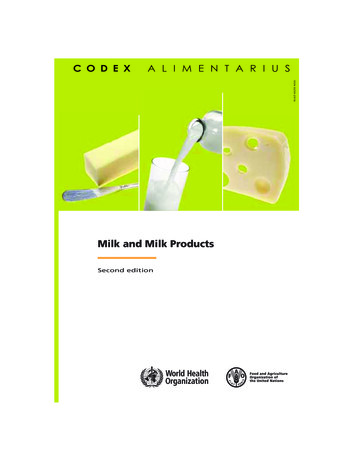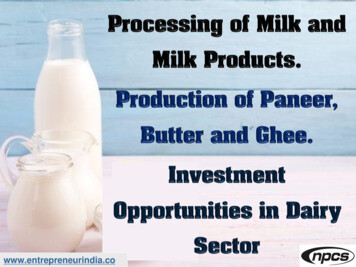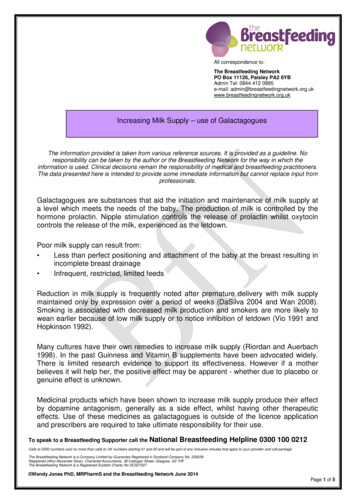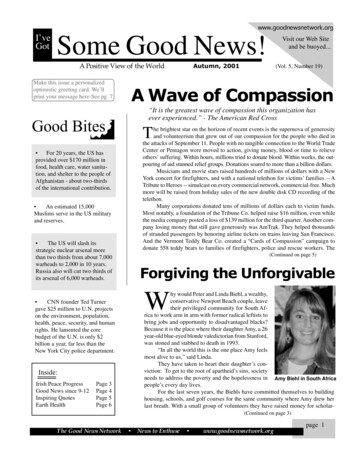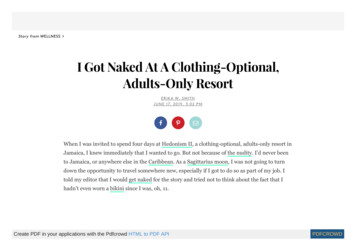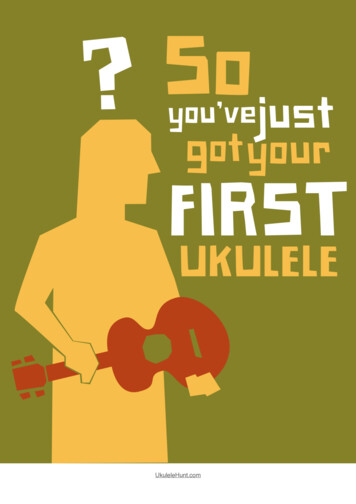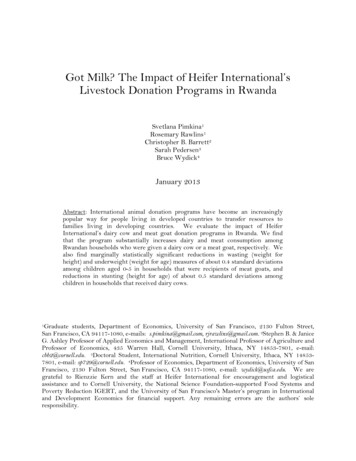
Transcription
Got Milk? The Impact of Heifer International’sLivestock Donation Programs in RwandaSvetlana Pimkina1Rosemary Rawlins1Christopher B. Barrett2Sarah Pedersen3Bruce Wydick4January 2013Abstract: International animal donation programs have become an increasinglypopular way for people living in developed countries to transfer resources tofamilies living in developing countries. We evaluate the impact of HeiferInternational’s dairy cow and meat goat donation programs in Rwanda. We findthat the program substantially increases dairy and meat consumption amongRwandan households who were given a dairy cow or a meat goat, respectively. Wealso find marginally statistically significant reductions in wasting (weight forheight) and underweight (weight for age) measures of about 0.4 standard deviationsamong children aged 0-5 in households that were recipients of meat goats, andreductions in stunting (height for age) of about 0.5 standard deviations amongchildren in households that received dairy cows.1Graduatestudents, Department of Economics, University of San Francisco, 2130 Fulton Street,San Francisco, CA 94117-1080, e-mails: s.pimkina@gmail.com, rjrawlins@gmail.com. 2Stephen B. & JaniceG. Ashley Professor of Applied Economics and Management, International Professor of Agriculture andProfessor of Economics, 435 Warren Hall, Cornell University, Ithaca, NY 14853-7801, e-mail:cbb2@cornell.edu. 3Doctoral Student, International Nutrition, Cornell University, Ithaca, NY 148537801, e-mail: sp729@cornell.edu. 4Professor of Economics, Department of Economics, University of SanFrancisco, 2130 Fulton Street, San Francisco, CA 94117-1080, e-mail: wydick@usfca.edu. We aregrateful to Rienzzie Kern and the staff at Heifer International for encouragement and logisticalassistance and to Cornell University, the National Science Foundation-supported Food Systems andPoverty Reduction IGERT, and the University of San Francisco's Master’s program in Internationaland Development Economics for financial support. Any remaining errors are the authors’ soleresponsibility.
I. INTRODUCTIONThe Food and Agricultural Organization of the United Nations estimates thatworldwide 870 million people are undernourished (FAO, 2012). One-third of the world’schildren are affected by delayed growth and development due to malnutrition, in addition to the40,000 children who die each day from malnutrition-related causes (Behrman et al., 2003). Inmany developing countries, decades of official aid appear to have had little impact on reducingpoverty and food insecurity (Sabates-Wheeler and Devereux, 2010).A number of non-profit international development agencies have sought to address thiscrisis, among them Heifer International, a U.S.-based nongovernmental organization (NGO)whose mission is “to work with communities to end hunger and poverty and care for the Earth”(http://www.heifer.org/ourwork/mission). During the organization’s 60 years of operation,Heifer projects have reached millions of people spanning 128 countries through its signaturelivestock donation programs, complemented by training in livestock care, environmentalprotection, business development, leadership, and gender equality. The extensive track recordand favorable public opinion of Heifer’s – and other NGOs’ – animal donation programsnotwithstanding, there has been no prior rigorous quantitative evaluation of these programs’performance that we or Heifer could identify. Given that animal donations are expensive –Heifer (personal communication) reports that the average full cost of a pregnant cow, deliveredto the Rwandan beneficiary households we study, is roughly 3000 –solid evidence of impact isarguably long overdue.The research we report in this paper evaluates the impact of two of Heifer’s animaldonation programs in Rwanda, one that donates dairy cows, and one that donates meat goats.One cornerstone goal of the Heifer program is improving the nutritional outcomes ofparticipating households.We therefore examine program impacts on household dietarydiversity and on child nutritional attainment as determined by stunting, wasting, andunderweight measures.Using several econometric models, this paper compares beneficiary households withhouseholds likewise targeted for animal donations but that have not yet received animals, andwith households that were not approved to receive animals. The results show large and highlystatistically significant increases in household dairy consumption and household meatconsumption among dairy cow and meat goat recipients, respectively. Our findings alsoindicate that livestock donations positively impact child health and nutrition, as evidenced byanthropometric data. Donations of dairy cows have a significant correlation with improvementin stunting measures of children, but have no effect on wasting measures, whereas donations of1
meat goats are significantly correlated with improved wasting measures without affectingstunting measures. In some specifications, donations of meat goats as well as dairy cows arealso correlated with improved underweight measures.II. BACKGROUNDMalnutrition results from a combination of an inadequate intake of calories,micronutrients, and high-quality protein (Black et al. 2008, Victora et al. 2008). Researchincreasingly demonstrates that animal-source foods provide complete protein, energy, and anarray of micronutrients that are often limited or unavailable in the rural peasant diet(Scrimshaw, 1994). In addition to providing a good source of protein and calories, meat andmilk products are an important source of calcium, selenium, zinc, and vitamins A and B-12.Inadequate intake of these nutrients is associated with anemia, poor growth, rickets, impairedcognitive performance, hypothyroidism, blindness, and neuromuscular deficits. Even relativelysmall amounts of animal-source foods can substantially increase nutrient adequacy (Murphyand Allen, 2003). While there are other methods of obtaining these micronutrients, it isdifficult to even approach meaningful levels of nutrients such as calcium and vitamin B-12 on aplant-based diet with a poverty-level income (Murphy, Beaton, and Calloway, 1992). Lowincomes, in tandem with limited access to animals, often means that poor households consumefew animal-source foods, are forced to rely on less expensive, imperfect substitutes, and theirchildren suffer malnutrition (Neumann et al., 2002).In a review of the challenges facing child nutrition in sub-Saharan Africa, Lartey (2008)notes that early childhood malnutrition likely accounts for the high prevalence of stunting andunderweight measures reported for children. In Africa, 40% of children younger than five yearsold are moderately or severely stunted (UNICEF, 2010). Many cross-sectional studies of highrisk children have identified associations between stunting and cognitive ability. Comparedwith non-stunted children, stunted children are less likely to be enrolled in school, more likelyto enroll late, to attain lower achievement levels or grades for their age, and have poorercognitive ability or achievement scores. Although there are fewer studies concerning youngerchildren, several empirical connections have been established between child developmentmeasures and height-for-age, as well as weight-for-age.For an overview of these findings, seeGrantham-McGregor et al. (2007).The earliest stages of life for children are both “sensitive,” since the effects of experienceduring this time on neural and physical development are unusually strong, as well as “critical,”since these effects are largely irreversible (Knudsen, 2004). In this vein, economic orenvironmental shocks early in life have been shown to affect future outcomes (Victora et al.2
2008). A study of drought and civil war in the first two years of a child’s life has shown areduction in child height and schooling (Alderman et al., 2006), while beneficial rains in theyear of a girl’s birth are associated with an increase in her adult height, years of schooling, andwealth (Maccini and Yang, 2009) and participation in an early childhood nutrition interventionis associated with increased adult educational attainment, body size and work capacity, as wellas higher adult economic productivity and wages (Hoddinott et al. 2008, Maluccio et al. 2009,Martorell et al. 2010) .For many of the poor in the developing world, livestock ownership offers a potentialpathway out of poverty and malnutrition. In a household facing imperfect markets, there arevarious channels through which livestock ownership impacts the health and nutrition status ofhouseholds. The following framework (adapted from Nicholson et al, 2003), presents thepositive and negative implications of livestock ownership on health outcomes.The direct health benefits of livestock ownership lie in the increased availability andconsumption of animal source foods which provide essential nutrient supplements and dietarydiversity and mitigate seasonal fluctuations in food crop availability (Murphy and Allen, 2003;Wilson at al., 2005). Through sales of animal products, livestock ownership also increaseshousehold income, which can be used for the purchase of higher-quality healthcare and foodthereby increasing nutrient bioavailability to household members (Senauer, 1990; Kennedy,1994). The gender pattern of income control affects household’s propensity to spend additionalincome on food and health related items (Thomas, 1997; Tangka et al., 2000), since femalecontrol of household resources is often associated with consumption preferences which favorbasic needs and child welfare (Rogers, 1996). Because women and girls commonly bearhusbandry responsibilities for lactating animals (and poultry), increased holdings of suchlivestock commonly gives women greater control over resources within the household (McPeakand Doss 2006). Additionally, livestock contribute to efficient nutrient cycling by increasingsoil nutrient content and crop yields (Delve et al., 2001).However, due to time and resource constraints, increasing livestock ownership maydecrease the (financial and time) resources devoted to food crops, reducing production,consumption and sales. Unconfined livestock also commonly damage standing or stored crops.Animal keeping can also raise the incidence of zoonotic disease, either through directtransmission or contamination of food and/or water resources. By increasing labor demand,especially from the females of the household, animal ownership may decrease the time andquality of care for children (von Braun et al., 1994; Huffman, 1987).The possibility of both positive and negative effects of transferring livestock to poor,3
rural households raises the natural question: what net impacts do animal donation programshave? To the best of our knowledge, there has been no prior, rigorous study on the net impactof livestock donations. However, extensive research has been done regarding the impact ofanimal ownership on various health and nutritional outcomes. A comprehensive three-countrystudy showed that the intake of animal-source products positively affected both physical anddevelopmental outcomes in children, illustrating the potential utility of these foods in the diet(Neumann et al., 2002; Neumann and Harrison, 1994; Harrison et al., 1987). Several studiescarried out in East Africa have found a positive association between dairy cow ownership andthe nutritional status of children. Hitchings (1982) showed a positive correlation between childheight and the ownership of a milk cow, conditional on milk being used for family consumption.Leegwater et al. (1991) provide evidence that the nutritional status of pre-school children in thehouseholds participating in the National Dairy Development Project in Kenya was better thanthat of children from non-participating households. Vella et al. (1995) show that the ownershipof a cow in rural Uganda is a significant predictor of median child height-for-age, while Grosse(1998) finds that in rural Rwanda, an index of dairy animal ownership has a strong positiveassociation with child height-for-age. In contrast, studies examining the role of non-dairylivestock tend to indicate that ownership of these animals has no strong relationship with childnutritional status (Annan, 1985; Vella et al., 1995).III. DATA AND METHODOLOGYOur data come from surveys of 406 households collected during the summer of 2011 inRwanda, a small, densely populated country in East Africa. Heifer International has manyongoing projects in Rwanda, donating a wide variety of animals and providing variouseducational interventions. Our research team conducted surveys in two regions, one in whichHeifer had initiated a dairy cow donation program and the other in which the organization hadcarried out widespread donation of meat goats.In the dairy cow region, Ruli (northernRwanda), 224 households were surveyed. In this region, Heifer donates dairy cows to coffeefarmers belonging to two distinct coffee cooperatives. The goal of the program is to increasedairy consumption and production in the region (as well as to increase coffee output via afertilizer access program).In order to qualify to receive a dairy cow, applicant households must meet a given set ofrequirements. The most stringent requirements are that households have at least one hectare ofland, and they must commit to constructing a shed with a cement floor and metal roof to housethe cow. (Once selected, Heifer provides loans to the beneficiaries to purchase buildingmaterials.) Households must not currently own a high-producing dairy cow, however, owning4
local-breed cows, which have much lower milk yields, is permissible. Note that eligiblehouseholds are neither the poorest – who cannot afford to meet the program requirements –nor the richest – who might already own the most productive livestock breeds available. Thisnon-random eligibility necessitates paying attention to selection criteria and to making aconcerted effort to properly control for prospective ex ante differences between animaldonation beneficiaries and non-beneficiaries in program evaluation. Such ex ante differencescould easily be independently correlated with differences in food consumption patterns andchild anthropometric indicators of nutritional status.Beyond these requirements, Heifer International was unable to provide a clear set ofsecondary selection criteria. According to Heifer International staff, beneficiaries are selectedbased on need as determined by a team of assessors. During the selection process, Heifer staffvisit applicant households and review various household characteristics such as income, numberof children, widow(er) status, etc. Upon selection, Heifer gives each beneficiary household animported, pregnant cow. The imported cows produce a significantly greater amount of milkthan the local cow breeds (up to 15 liters of milk per day after they give birth). Beneficiaryhouseholds are required to give away the first female offspring of their cow as part of Heifer’s“Pass on the Gift” initiative. If the offspring is a male (bull), beneficiaries may sell it for aconsiderable profit (approximately US 250- 1,000). Heifer International provides ongoinginsemination services to beneficiaries so that the dairy cows may continue to produce milk andoffspring.The sample for this research was chosen to include only recipients of first-generation imported dairy cows, not recipients of cows via the “Pass on the Gift” program.In addition to the dairy cow program, an additional 182 surveys were collected fromhouseholds in Heifer’s meat goat region, Kirehe (eastern Rwanda). Kirehe is near the Tanzanianborder, and is home to a large population of refugees who returned to Rwanda after the 1994genocide. The area is much poorer overall than Ruli, with limited access to markets and lessdeveloped infrastructure. In Kirehe, the meat goat program is designed specifically as a povertyreduction tool and thus the participants are noticeably poorer than in Ruli. Researchers notedthat Heifer’s meat goat donation program is not as well organized or operated as the dairy cowprogram. While there is still an official requirement that beneficiaries build sheds to house thedonated goats, the research team noticed many households where goats were tied to trees, orkept on concrete slabs with no roof. Upon selection into the program, each beneficiaryhousehold is given two female goats. A few beneficiaries in each area are also given a male goatto breed with the area’s female goats. Heifer expects households to breed the goats for saleand/or consumption.5
In both regions, the sample is divided into three groups. The first group consists ofhouseholds that received an animal (dairy cow or meat goat, depending on the region) one yearprior to the survey; we refer to members of this group as “Beneficiaries.” The second groupconsists of households that applied to receive an animal and were approved to receive one in thenear future (within a month following the survey); we call members of this group“Prospectives.” The last group consists of households that applied to receive an animal in theupcoming cycle, but were excluded by Heifer during the screening process; this group we call“Nevers.” For the purpose of this paper, the group “Qualified” includes both Beneficiaries andProspectives—that is, all households in the sample that were qualified and selected to receiveanimals from Heifer International either the year prior to or at the time of data collection.All households surveyed are similar in that they all expressed an interest in receiving ananimal by applying to the livestock donation program.Thus, a household’s programparticipation was determined by Heifer’s eligibility criteria. We undertook substantial effort toascertain why the Beneficiaries were given first priority to receive the animals among allqualified families out of concern for unobserved heterogeneity issues, but were never givensatisfying answers to this question. It appears that in some cases the first round of donationswere distributed to highly prioritized families, while in other cases the decision was made basedon logistics. Unfortunately, this decision-making process was not systematic program-wide.To the extent that idiosyncratic factors related to first-round selection are orthogonal toimpact variables, we are able to ascribe causality to our impact estimation results. We carryout robustness checks in our estimations to see how sensitive the significance of our results isto potential endogeneity related to the order of animal distribution.If anything, poorerhouseholds with more malnourished children and limited access to animal-source foods weretargeted for initial donations, so our estimates of program impact should, if anything, be biasedagainst finding a favorable effect on dietary diversity and child nutrition outcomes.Heifer staff provided lists of Beneficiaries, Prospectives, and Nevers in each region, andthe team attempted to survey every listed household. If household members were not easilycontacted, multiple efforts were made to reach them, including phoning friends and neighbors,and visiting houses multiple times to establish contact. In the event that the animal recipient orapplicant was not present at the time of visit, the spouse or the eldest member of the householdwas interviewed.The regressions we estimate take the general form:Y 0 1(Qualified) 2(CowBeneficiary) 3(Goat6Beneficiary) 4(North) (Controls) ei(1)
where Y is a measure of nutritional outcomes, “Qualified” is a dummy variable indicating thatthe household either received an animal last year or will receive one soon (i.e., is either aBeneficiary or Prospective household). The estimated2and3coefficients measure themarginal effect of receiving a cow or goat, respectively, given that a household requested andqualified to receive an animal from Heifer International. The Qualified variable controls forany u
Francisco, 2130 Fulton Street, San Francisco, CA 94117-1080, e-mail: wydick@usfca.edu. We are grateful to Rienzzie Kern and the staff at Heifer International for encouragement and logistical assistance and to Cornell University, t
